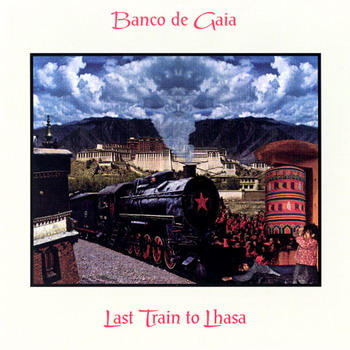Banco De Gaia – Last Train To Lhasa
 |
Banco De Gaia Last Train To Lhasa 1995
CD1.2 Kuos CD1.3 China (Clouds Not Mountains) CD1.4 Amber CD1.5 Kincajou CD1.6 White Paint CD1.7 887 (Structure) CD2.1 Kuos (Gnomes Mix) CD2.2 Kincajou (Duck! Asteroid) CD2.3 Eagle (Small Steppa Mix) CD3.1 China (Follow The Red Brick Road) CD3.2 Amber (Insect Intelligence) CD3.3 887 (Darkside Return) |
______________________________
LAST TRAIN TO LHASA is indeed a timeless and iconic album, which is created by a well-known to all and well-liked artist Banco De Gaia, who is no one else, but an English musician, Toby Marks. The album from 1995 has been released in thirteen versions by various labels, but this three-CD album by Planet Dog is the most recognized by most of the listeners. What distinguishes this album from others? Why is it such a cult item? It is very simple, it is not the musical content of this album that is so important, but the ideology that comes straight from the author himself, who tries to draw attention to the suffering and persecution of the Tibetan people. Shortly after a huge success of one of the first albums, which was MAYA and a common European tour with the musicians from Transglobal Underground, Toby began to collect his first inspirations associated with the culture of the East, and especially with Tibet that was oppressed by the Chinese people. That is how he became a member of The Tibet Support Group, which is a part of International Tibet Independence Movement. In a response to the protest against the construction of the railway line between Xining and Lhasa, Toby created a track lasting twelve minutes which was the nucleus of this album. The record which was a result of political behavior and lack of respect for another human being. The title, lasting twelve minutes protest song became a recognizable sign for each of us; probably there is not anyone who does not recognize this track which was 'built’ on the top of the locomotive bursting of steam, looped and supplemented with some Tibetan songs. This track has achieved a highly recognizable video clip showing the daily life of the Tibetan people, their culture, traditions and the worse part, that is the persecution by the Chinese people.
Source: Banco De Gaia – Last Train To Lhasa
Following the rushing locomotive, we get to KUOS, a track that combines its initial great ethnic character with a rather pretentious beat, which is probably not entirely successful, but once again some brilliant, Tibetan chants allow us to feel the purpose and the main message of this album. The same track we get served on a tray also in the album number two, but this time it is a version GNOMES MIX, which sounds much better than the original one. Some Tibetan voices have been replaced by a slight grunt of ethnic instruments, which made better the atmosphere of the track and it has become more mysterious and fascinating in its own way. CHINA – it tells us a brief history of the old man and his child, who daily have to climb the huge mountain to get to their fields. One day, the old man decided to move the mountains to facilitate the access to the field, so with the child he began to flip through a stone by stone, until one day a traveler passing by asked them if that was possible, that they were able to move such huge mountains. The old man replied that he probably would not be able to do it, but he has got children, the children will have their own, and they will continue his work until they reach the desired goal. This kind of objective was achieved by the Chinese people, maybe not literally by moving the mountains, but in a different way, and this track became the defeat song of the Tibetans. When we listen to this track, it is quite sad and depressing, and the sound of the sitars and harps only deepens that mood. The version FOLLOW THE RED BRICK ROAD included in the album number three also does not inspire optimistically, but it only implies clearly of what a man can be capable. After some tracks that are not very encouraging we quite melodic and interesting AMBER. An oriental track with a large dose of some interesting and looped sounds with male vocal added, which seems to sing something like a hymn of praise – but maybe it is just my feeling. In any case, the track is interesting, but certainly it does not knock on the knees. Just the same as some predecessors, AMBER received its different version as INSECT INTELLIGENCE (album number three) and in addition to that it is only a little longer than the original, nothing really special distinguishes it. KINCAJOU – nice and pleasant, a bit sweet and joyful. A good escape from the preceding, some pensive compositions, but probably it is much better to pay attention to the CD number two and the version DUCK! ASTEROID, which lasts up to thirty six minutes. Some pleasant, roaming audio spots of this track in conjunction with such a long duration even hypnotize and draw us into a blissful lethargy of travelling in Tibetan cities. The atmosphere built from second to second, without any stronger impact only enhances the incredible strength and character of this track. I must admit that this is probably the best position in the album. WHITE PAINT tries to be a great track, but it is sometimes a bit distracting. This is kind of mixture of the good and bad, which in my opinion did not succeed. The first disc ends with 887 (STRUCTURE) – the track that builds the atmosphere of calmness and despite the fact that, when it seems that suddenly it will shoot, and bear us in the distant skies, it all comes back to the delightful, delicate sounds. Here it is also worth to mention the amazing, mysterious sounds that appear somewhere in the middle of the track. Those are some kind of sounds of the busy life or the beating of some Tibetan bells, I must admit that also this time Toby has risen to the heights of his abilities, and I will not be wrong if I say that here he drew a lot of inspiration from a group The Orb. Also the track 887 has another version of itself – DARKSIDE RETURN (the album number three). This time, I am a supporter of the original version, and even if this more than twenty-minutes version is a really good one, however the atmosphere of this track is too overwhelming for me. To close the whole, we have to mention about the last track contained in this three albums release, namely EAGLE (SMALL STEPPA MIX), which is in the second disc. This is the track slightly differing from the previous references to Tibet, but once more it is similar to the tracks of The Orb. EAGLE becomes a spaceship APOLLO 11 and travels with us to the universe in search of a better tomorrow not only for us, but also for those few millions of Tibetans.
This kind of album or albums cannot be summed up clearly. Here we have both a large dose of solid music, as well as a large dose of thoughts which are not connected with music. Each of us will find something in here that will definitely remain in the memory for a long time, and we will want to come back again to this album.
Let each of us judge for himself how much this album is worth.
______________________________
8 / 10
Tofik

![Ashoka [Sun, Love, Peace and Chillout...] Ashoka [Sun, Love, Peace and Chillout...]](http://www.ashoka.com.pl/download/cd_covers/digiseeds.jpg)
![Ashoka [Sun, Love, Peace and Chillout...] Ashoka [Sun, Love, Peace and Chillout...]](http://www.ashoka.com.pl/download/cd_covers/granite.jpg)



